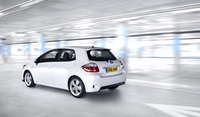Toyota Auris Hybrid ahead on value

Proving that advanced, low emissions technology need not cost the earth, the new, British-built Toyota Auris Hybrid has the measure of its main market rivals on value for money.
Europe’s first full hybrid C-segment model, it combines family-friendly five-door practicality with the proven low emissions, high efficiency, quality and reliability of Toyota’s Hybrid Synergy Drive. In performance terms, the 134bhp Auris Hybrid matches conventional 2.0-litre diesels, but with significantly lower emissions and better fuel economy. All versions of the car achieve sub-100g/km performance (89g/km with 15-inch wheels, 93g/km with 17-inch wheels), which means owners pay no annual road tax (Vehicle Excise Duty). Insurance is also competitive, with a 13E group rating.
The profile is even more attractive for company car drivers, who enjoy for a car tax benefit-in-kind rating of just 10 per cent. The model also qualifies for a 100 per cent Corporation Tax write-down in the first year.
Thanks to combined cycle fuel consumption of 74.3mpg (70.6mpg with 17-inch wheels), Auris Hybrid drivers will be paying out a lot less at the pumps, too.
The great reliability of Hybrid Synergy Drive has been proven by its successful installation in Prius, which has achieved the lowest warranty cost per unit of any Toyota model. Emphasising quality, reliability and peace-of-mind ownership, Auris Hybrid, like all new Toyota cars, is covered by a five-year/100000-mile manufacturer warranty.
Residual values are also expected to compare well with the best in the C-segment, calculated by Toyota Financial Services (TFS) to be 38 per cent after three years/60,000 miles.
Parts and servicing
Auris Hybrid’s 10,000-mile service intervals maximise the benefit of the car’s component lifetime efficiency. The Hybrid Synergy Drive system itself has been designed for low maintenance requirements and durability, and has no need for a conventional starter motor or alternator. The 1.8-litre VVT-i petrol engine has a maintenance-free timing chain, an element-type oil filter, miniaturised spark plugs and no drive belts, features which deliver worthwhile cost savings.
Thanks to the efficiency of the Electronically Controlled Braking System, the front and rear brake pads are good for 40,000 and 70,000 miles respectively. High tyre pressures (2.4 or 2.3bar) reduce wear significantly, with typical durability of more than 30,000 miles. The standard 15 and 17-inch tyres also cost less than purpose-made alternatives.
The exhaust system is expected to last for more than five years, thanks to its high stainless steel content and the LED lamp bulbs have a 20-year lifespan.

